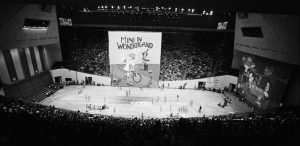
By: Jordan Siden, Bicentennial Intern, Class of 2017, History, Bloomington
Beginnings: 1955 to 1971
“Women Behind the Men Make the Race a Success,” read the headline to Lynn Sproatt’s article in the Indiana Daily Student on April 17, 1955, a little over a month before the fifth running of the annual Little 500.[1]
“For weeks before the race, team members will be pedaling all over campus and the countryside,” Sproatt wrote. “This sort of thing, persons notice. But behind the scenes, coeds who ordinarily wouldn’t know which end of a needle to thread will be stitching uniforms with clever—or simple designs.”
On the day of the race, the article continued, the co-ed sponsors would arise before the sun, head to the stadium, and install the decorations they had worked so hard to make. The dedicated, yet underappreciated co-ed sponsors to the Little 500 teams cheered on the riders, sewed their uniforms and designed the decorations for their pits.
“When the race is over, a team of bicyclists— men—will be declared winner of the Little 500,” Sproatt wrote. “But behind that team, there will have been a coed unit who will gladly take second place, no matter how much credit is due her, because that’s how things seem to fall in this world.”
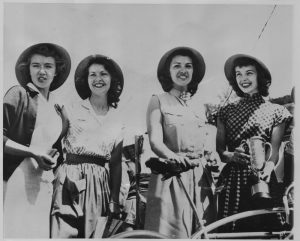
Though the women of IU had played only peripheral roles in the early years of the Little 500 bicycle race, on the front page of the same paper a new event was announced that promised to feature their speed, skill and talent.
Members of the Pi Beta Phi sorority had organized a race open to all women’s housing units, “an added attraction to make the 500 weekend a fuller one.”[2] The IU Student Foundation, who organized the annual Little 500, would develop the sorority’s race into the newest event of the Little 500 weekend.
It meant that after four years on the sidelines, women at IU now had their own chance to compete as part of the festivities. Teams of four riders with one alternate would race for cashmere sweaters and clock radios to see which one could pedal the fastest. Prizes would also be given to the team with the best costume.
The race would be called the Miniature, and the women would race on tricycles.
But while the annual Little 500 grew almost immediately into one of the most emblematic cultural events at Indiana University — an event which had been marketed as the “World’s Greatest College Weekend” since its first running in 1951 — women were kept out of the bicycle race until the hard-fought creation of the Women’s Little 500 in 1988.
Instead, in 1955, a precedent was set. At IU, while men raced on bicycles in the Little 500, women raced tricycles in the Mini.
It was a decision that allowed for men’s and women’s experiences to be very different for students participating in IU’s Little 500 weekend. The bicycle race made heroes out of college men, and its counterpart made spectacles out of IU’s women.
The Mini 500 would be raced every year until 2002. Throughout its history, it would act as a barometer measuring how ideas of gender roles changed at IU’s Bloomington campus.
In the wake of the G.I. Bill, IU was an institution growing in size and exploding in population. In 1950, wanting to get the fledgling IU Foundation off the ground, IU President Herman B Wells invited Howard “Howdy” Wilcox Jr., a 29-year-old fresh out of the army and working for an advertising firm in Indianapolis, to come to Bloomington and become the foundation’s new executive director.[3]
Wilcox knew the key to the foundation’s success was to plant the seeds of philanthropic responsibility in students early, and he developed the IU Student Foundation, the student arm of the organization. Though a small body of students were eager about the foundation’s mission, Wilcox was still in need of a way to prepare the student body at large to regularly and annually invest in the university once they became graduates.
The story of how Wilcox, the son of a famed Indianapolis 500 racer, came up with the idea for the fundraiser for working students is a story that has been told and retold in the days leading up to the Little 500 for decades. And like any great piece of cultural mythology, the details differ in its various re-tellings.
An IU News Bureau press release in 1990, a standard pre-race feature of the Little 500’s founding story, describes Wilcox’s eureka moment: “Screams and cheers coming from a nearby IU dormitory interrupted [Wilcox’s] peaceful afternoon and lured him to find out what the commotion was all about. He followed the cheers and surprisingly found about 50 women screaming out their dormitory windows. They were cheering on five cyclists who were intensely racing around the dorm.”[4]
Wilcox immediately saw the potential. He would stage a bicycle race modeled after the Indy 500, and its proceeds would go to working students.
While most accounts of the Little 500 origin story make no mention of the screaming fans’ gender, this detail provides an important clue for understanding the role women students played at IU in Wilcox’s time.
In 1951, no rule stipulated that women couldn’t ride in the Little 500. There was no need for one. It was simply a given that the athletes to participate in Wilcox’s race would be men.
Beyond IU, women’s roles on college campuses were precariously susceptible to societal forces. During World War II, women in higher education were met with a brief period of unprecedented opportunities in technical and professional training “that seemed to belie sex labels,” Barbara Miller Solomon wrote.[5]
But, in the wartime absence of men, this moment toward equality disappeared once G.I.s returned home to enroll in universities by the millions. A curriculum and student culture focused on preparing women for domestic life and marriage came to dominate educational priorities for collegiate women in the 1950s.
IU was no exception to the sudden, nationwide shift in favor of a “distinctly feminine education” for the modern woman. IU graduate student Julia Joshel writes that the activities of IU’s residence halls was one way IU trained women undergrads “the development of attributes suitable for a housewife.”[6]
By sewing uniforms, cheering on the men and decorating the pits, the Little 500 in the 1950s was another way for women to practice their domestic duties.
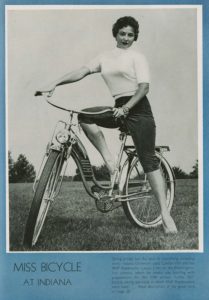
In the early years of the Little 500, women were photographed atop or next to bicycles, but only to pose in advertisements for the upcoming race and its many corresponding social events.
From the first Little 500 in 1951, some women did ride bicycles competitively in the Little Little 500, a relay race between the Kappa Alpha Theta and Delta Gamma sororities the morning of the Little 500. The event was a challenge to race around a track while dropping an egg from a spoon the fewest number of times.[7]
The winning team, appropriately, would win an eggbeater. The “Little Little” was run annually until 1960.
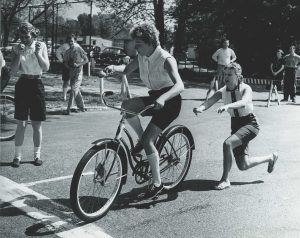
But while women riding bicycles was considered a novelty during IU’s Little 500 weekend, the invention of the bicycle had, in fact, once played a central part in the advancement of women’s rights.
In late 19th century, bicycles provided women a means to leave the domestic sphere of home and experience newfound mobility and individuality. As Robert A. Smith writes, the bicycle “is credited to challenging the conventional forces dictating what women could and could not do.”[8] Susan B. Anthony said in 1896 that the bicycle “has done more to emancipate women than anything else in the world.”[9]
Though tricycles appeared as the first popular alternatives to the earlier high wheeled, cumbersome and difficult to ride bicycle of the mid-nineteenth century, Sarah Hallenbeck writes it was the development of the “safety bicycle”—the low-bar prototype to the contemporary bicycle—that would broaden the accessibility of cycling to include women and set off the bicycle craze of the late 19th century.[10]
And beyond just leisurely riding, Clare S. Simpson found that by the late 1890s women competed professionally in bicycle races staged across the United States and England.[11] Scores of women raced in competitions staged and funded by promoters eager to entertain. Though novelty and sex appeal did contribute to the success of women’s bicycle racing, its history demonstrates that since the 19th century women were capable and ardent athletes on two wheels.
The short-lived phenomenon of women’s bicycle racing had largely disappeared by the beginning of the 20th century. Fifty years later, the idea of college-aged women racing on bicycles would have seemed laughable. As the Little 500 bicycle race would expand, women at IU would be left out of the race and placed into what were considered more appropriate, feminine roles.
Bill “Army” Armstrong, who succeeded Wilcox to become the executive director of the IU Foundation in 1953, would very rapidly grow the Little 500 into a full weekend of entertainment—broadening its appeal to enlarge its audience.
Armstrong’s first major addition to the weekend was the introduction of the Little 500 Sweetheart, a young female model, beauty pageant winner, singer or dancer who was expected to kiss on the lips each member of the winning Little 500 team. She was a prize written about extensively in the IDS and local papers into the 1960s.
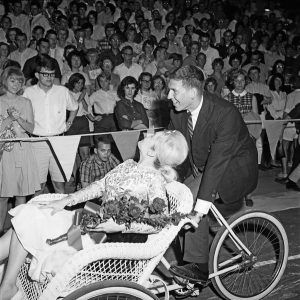
The 1955 Little 500 included about a dozen social events, including luncheons, ice cream socials, parades and receptions. Armstrong’s new Variety Show brought celebrities and comedians to Bloomington, and fraternity dances like the Bicycle Bounce and Sprocket Hop provided a convenient stage for men and women to mingle.[12]
So when the Miniature 500 was announced, it was heralded as an exciting role-reversal, an event that would give an opportunity for women to share in the fun and enjoy a moment in the spotlight.
“Our ‘Little 500’ week-end is no longer a campus-confined ‘men only event,’” the official 1955 Little 500 program announced.[13] Staging a women’s race meant that men, for just one night, were to switch with the women as the cheering supporters.
Since co-ed sponsors dutifully filled the stands of the Little 500 as supporters to the men’s teams, men who would participate in the Mini were asked to form a cheering section for the team that would back them the next day.[14]
But unlike the Little 500, the Miniature was a stage for demonstrating petite-ness — not physical prowess. “You have to be tiny to ride in the ‘Minnie,’ or you’ll get your knees bruised,” quipped the satirical student paper the Crimson Bull in the days leading up to the first race.[15]
The first Miniature 500 was supposed to have taken place in the parking lot outside the IU Auditorium, but rain moved the event into the Fieldhouse on Seventh Street, and established the basic configuration the race would take in every subsequent running.
In the style of the Little 500, each team in the Miniature shared one tricycle. To exchange it required the first rider, pedaling at top speed down the straightaway, to leap off the tricycle while her teammate would run alongside it and grab its handlebars to leap atop it herself.
For a race called the Mini, the oval tracks were appropriately narrow, and quickly negotiating the turn at each end of the track required a careful combination of strength and balance. The fastest team would advance to the next round, leading to a final, deciding heat.
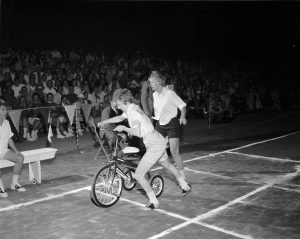
And though the Little 500 bicycle race was already referred to endearingly as a “watered-down version of the Indianapolis Memorial Day classic” for college kids, the Miniature took this idea a step further.[16] The very name of the competition articulated the message that, compared to men’s race, the women’s race was an even more diminished display of childish fun.
Though the Miniature 500 set a stage for women to compete, it was also an infantilized rendition of the Little 500 fit for displaying women’s perceived inferiority. “Short girls have suddenly become very popular in the housing units because they are the only ones who can ‘gracefully’ manage the children’s tricycles,” Susan Wallace wrote for the IU News Bureau before the first Miniature in 1955.[17]
A parade of women carrying extravagant floats began the Miniature, and the Little 500 Sweetheart would be pedaled around the track by the man who’d raced the fastest qualifying lap for the Little 500. Teams raced in their costumes in the first years of the Mini 500. Kappa Kappa Gamma won the first Miniature dressed as wooden soldiers.[18]
Nine-year-old Billy Shaw pedaled a custom-built Austin Motors toy pace car that night. Children were featured regularly in the Mini’s opening procession for decades.[19]
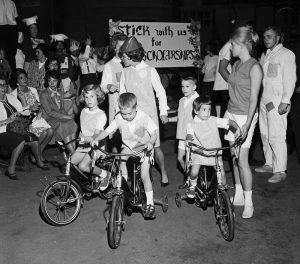
The following year, the IDS wrote 5,520 people attended the Miniature 500, who enjoyed a “carnival atmosphere” provided by a calliope player.[20] Kappa Kappa Gamma won once again, and Chi Omega won the costume prize dressed as Roman charioteers.
Changes would be made to the Miniature by way of annual repetition. In 1959 the first theme, Carnival of Trikes, was introduced, and a theme would accompany every subsequent running of the race. The race soon became so popular that a round of qualifications was needed to reduce the pool of teams to 63.

By the 1960s the race would officially be called, succinctly, the Mini 500.
In 1961 the event moved to the new 17th Street Fieldhouse. And while written accounts once emphasized the rider’s prettiness, petite-ness, and inclusion in the broader weekend, by the mid-1960s participants in the Mini 500 were praised instead for their speed and skill.
No longer chided as petite, writers began attributing riders in the Mini with toughness, and in some cases, mannish-ness. “Ever wonder what happens to tom boys who grow up?” posed the IDS in 1965. “They ride in the Mini.”[21]

The tricycle race was an event most teams trained for. Coaches, usually men, were commonplace on Mini 500 teams. Teams of women practiced in dormitory parking lots through all weather in the months leading up to the race.
Modifications were made to the trikes leading up to the 1966 Mini, which included solid steel handle bars, motorcycle spokes and the removal of an unnecessary step on the tricycle’s back deck. “We had to add new safety features on the trikes because the girls are so rough on them,” explained a Mini organizer to an IDS reporter.[22]
But while coverage increasingly focused on athleticism, the Mini could not shake off its tendency to objectify its participants. “It’s good to see a girl who isn’t afraid of breaking a nail or getting a run in her stocking,” the IDS continued. “Besides, most of them are cute enough that a couple of bruises don’t detract much.”
In 1972 the Mini 500 moved to the newly opened Assembly Hall. The same year Title IX was passed to protect the rights of women in any federally funded institutions — and has since become synonymous with equal rights for women’s athletics—the Mini 500 moved to the sleek floor in IU’s cherished basketball stadium.
When the first independent team won the Mini 500 that year, the IDS wrote about the tricycle race with Olympic fervor: “The whole crowd of at least 8,000 was on its feet as Funky’s demonstrated how the race should be ridden.”[23]
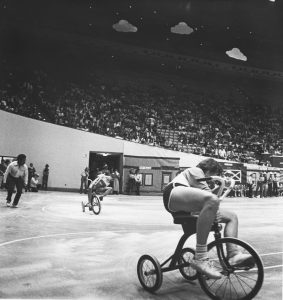
The move to Assembly Hall had another important consequence. The pace of the heats increased substantially. Funky’s, the IDS excitedly wrote, had broken the Mini 500’s record time in a semi-final heat at 39.6 seconds, and won the whole thing in another record-breaking final race of 40 seconds flat.
“Teams used to practicing on bumpy, gravelly surfaces were amazed to find themselves careening down the straightaway at record speeds, only to skid out-of-bounds on tricky hairpin turns,” wrote the IUSF in its 1973 pre-race brochure.[24]
Throughout the 1970s, qualifying times for the Mini 500 were published in the Bloomington Herald-Telephone right below the Little 500 qualifying times. And though the parades and pageantry continued to begin the event, the Mini never looked more athletic. Under bright lights and a slick concrete floor, teams dressed in matching T-shirts, high socks and gym shoes raced tricycles with determination.
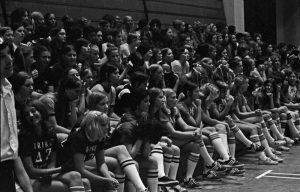
In the IDS and other local papers that covered the event, the rhetoric of Mini focused primarily on difficulty and tempo of the race: “Taut nerves typify Mini,” declared the headline to an IDS sports writer’s 1973 preview.[25] That year, the Alpha Sigma Phi team grumbled in the IDS about referee’s unfair calls.[26]
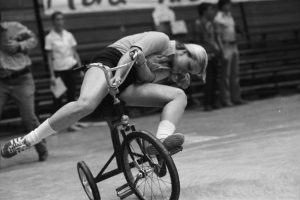
In the era of women’s liberation, women had also begun to knock at the door of the Little 500 bicycle race.
According to John Schwarb, author of The Little 500, six women who expressed interest in racing the 1973 Little 500 were barred from competing when their application was denied by the IUSF.[27] Only after filing a complaint with the Bloomington Human Rights Commission was the IUSF forced to allow women to at least attempt to qualify for the Little 500.
Though an enrollment technicality ultimately prevented the team from a qualifying attempt, it would foreshadow a decade of fights over inclusion. Women would begin to form bicycle teams and participate in the Little 500 qualifiers. But from 1973 onward, each of these attempts ended in disappointment—no all-female team raced fast enough to qualify for the necessary 33rd spot to compete in the Little 500.
The Mini would soon be rocked by a different battle for inclusion. While the tricycle race continued for the remainder of the 1970s, few would have sensed the trouble brewing ahead.
The Mini 500 had given women the opportunity to be included in the Little 500 weekend in a competitive event. During the 1980s, Assembly Hall would become a battleground in a greater fight for gender quality—a fight that would tear the Mini apart.
For part two of this blog, please visit: https://blogs.iu.edu/bicentennialblogs/2017/04/17/the-mini-500-the-gendered-history-of-a-forgotten-tradition-part-2/
Acknowledgments
This project could not have been completed without the help of several individuals, and a variety of organizations across the IU-Bloomington campus. Many thanks to Jim Capshew for all of his advice and encouragement, and for his endless patience through many revisions. Thanks also to Sarah Jacobi and the entire staff of the IU Bicentennial for their help and support throughout all stages of this project. Thanks to Kristin Leaman, Brad Cook, Dina Kellams, and the rest of the staff of the IU Archives. And finally, thanks to IU Student Foundation Director Tara Vickers for her enthusiasm and support for this project.
Works Cited
[1] Lynn Sproatt, “Women Behind the Men Make the Race a Success,” Indiana Daily Student, April 17, 1955.
[2] “Coeds to Pedal for Glory in Miniature 500,” Indiana Daily Student, April 17, 1955, 1.
[3] Wilcox, Howard S. “Howdy,” interview with Jean Freedman, Indiana University Oral History Research Center, OHRC accession #91-69-1, June 15, 1991, 6.
[4] “Howdy Wilcox Puts Idea to Work to Create 40 Years of Little 500,” Indiana University News Bureau, April 16, 1990, 1.
[5] Barbara Miller Solomon, In the Company of Educated Women: A History Of Women in Higher Education in America, (New Haven & London: Yale University Press, 1985), 188.
[6] Julia Joshel, “Education for Domesticity: Women in the Indiana University Halls of Residence, 1945-1960,” in Journal of the Indiana University Student Personnel Association, 2015, 9-18.
[7] “Mad Scramble!” Indiana Daily Student, (edition unknown), 1951.
[8] Robert A. Smith, A Social History of the Bicycle: Its Early Life and Times in America, (New York: American Heritage Press, 1972), 76-7.
[9] Louise Dawson, “How the bicycle became a symbol of women’s emancipation,” The Guardian, November 4, 2011, https://www.theguardian.com/environment/bike-blog/2011/nov/04/bicycle-symbol-womens-emancipation.
[10] Sarah Hallenbeck, Claiming the Bicycle: Women, Rhetoric and Technology in Nineteenth-Century America, (Carbondale: Southern Illinois University Press, 2016), 4.
[11] Clare S. Simpson, “Capitalizing on Curiosity: Women’s Professional Cycle Racing in the Late-Nineteenth Century” in Cycling and Society, ed. Paul Rosen, Peter Cox, and David Horton, (Burlington, VT: Ashgate Publishing Company, 2007), 47-66.
[12] Kathie Neff, “One-day Race Grown in to Weekend Full of Sports, Dances, and Shows,” Indiana Daily Student, (edition unknown), 1955.
[13] “Miniature 500,” 5th Annual Little 500, Indiana University Student Foundation, May 14, 1955.
[14] “Men’s Units to Cheer,” Indiana Daily Student, (edition unknown), 1955.
[15] “Now Minnie,” The Crimson Bull, (edition unknown), 1955, 13.
[16] “Handlebar Handicap,” Courier-Journal Magazine, May 22, 1955.
[17] Susan Wallace, “Get a ‘Trike,’ Quit Smoking and You May Win a Radio,” Indiana University News Bureau, May 7, 1955.
[18] Ibid.
[19] Dan Thomasson, “Kappas Pedal Hard To Cop Miniature,” Indiana Daily Student, May 14, 1955.
[20] Kent Nixon, “Kappas Cop Second Miniature 500,” Indiana Daily Student, May 12, 1956, 6.
[21] “Bruises (photo caption),” Indiana Daily Student, (edition unknown), 1965.
[22] “Rough riding Miniature 500 teams use custom built trikes for first time,” Irene Clare, Indiana Daily Student, (edition unknown), 1966.
[23] Tracy Dodds, “Funky’s burns track to win,” Indiana Daily Student, April 29, 1972.
[24] “Mini,”1973 Little 500, Indiana University Student Foundation, May 1973, 53.
[25] Rich Dotson, “Taut nerves typify Mini,” Indiana Daily Student, (date unknown), 1973.
[26] “Jordan River Forum: Mini 500 blues,” Indiana Daily Student, (date unknown), 1973.
[27] John Schwarb, The Little 500, (Bloomington, IN: Indiana University Press, 1999), 125.
I am a person and I think that this was a great endeavor on your part. carefully researched and noted. Congratulations, Noni